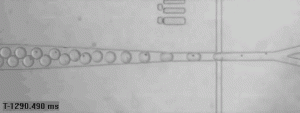New Advances in Single-Cell Genomics Allow Single Cell Investigation at Larger Scale

Computational biologist Aviv Regev at the Broad Institute in Cambridge, Massachusetts is developing a new technology to identify and study cells in the human body at a much larger and remarkable scale, and most significantly, at a single cell level. The ultimate goal is to create a detailed catalogue of cell types that could be further investigated for medical applications
Fluidic systems for investigation at a single cell level
The technology uses fluidic systems to isolate individual cell which is then subjected to genetic analysis via microscopic conveyor belts, at the rate of thousands per day. This has been used in investigating cells in mouse retinas and human brain tumors, which yielded astonishing results as new cell types not known previously were discovered. Such technology is a great advantage in medical applications as scientists will be able to analyze the roles of individual cells in health and disease as well as in executing various research concerning stem cell, cancer treatment and even basic studies of how tissues develop.

Individual cells are captured and separated in preparation for analysis. Credit: MIT Technology Review
Single cell analysis of human brain
With recent advances in single-cell genomics, other labs are also developing their own methods to improve such technology. Scientists at the Stanford University led by Stephen Quake. In April this year, the team has published a survey of all major cell types of the brain and the characteristics of subtypes of neuronal cells. The team has claimed to be the first to describe the single cell whole transcriptome analysis of the human brain, which lays the groundwork for developing a comprehensive cellular atlas of the human brain.
Single cell RNA sequencing of mouse brain cells
Single cell biologist Sten Linnarsson at the Karolinska Insitute in Stockholm, Sweden has also successfullt mapped several thousand mouse brain cells using single cell RNA sequencing. Every RNA molecule in each cell was attached to a molecular bar code, which resulted in a gene expression profile that shows molecular activity. With that, the researchers were able to identify 47 subtypes not seen before. These data provided transcriptional hints about the biology of the cells as well as uncovered the molecular markers that distinguish between the various brain cells.
Conventional methods in cell characterization
In the past, cell investigation and characterization were very much based on microscopic examination as done by pathologists to determine if cells are cancerous. One of the earliest methods introduced was to stain the cells with dyes.
With the development of new technology within single-cell genomics such as the work done by Regev, scientists will soon be able to catalogue all human cell types by gene activity, better understand how cells interact as well as to explore the potential medical applications.
Source: MIT Technology Review
